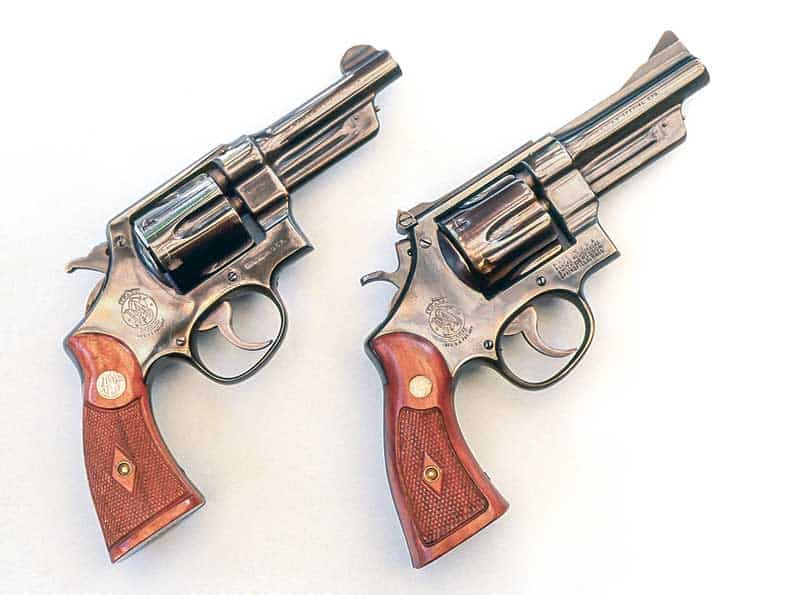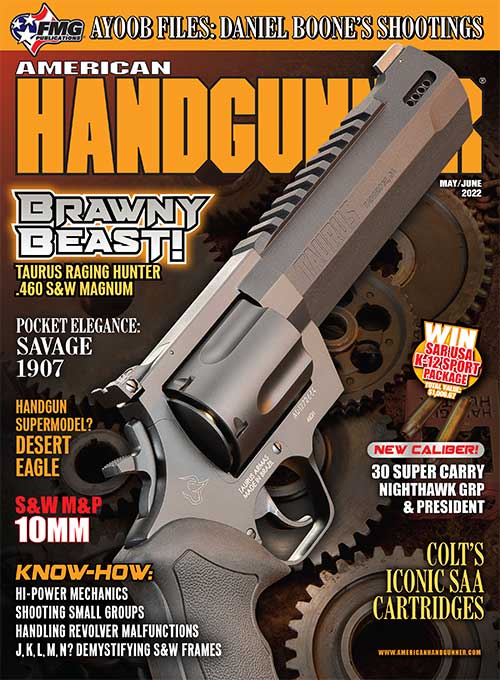The Sixgunner: The Third Model Hand Ejector
S&W's Model 1926 .44 Special
It is no secret that my passion is big bore sixguns. For most sixgun applications we can get by quite well with the old-time, pleasant shooting .45 Colt or .44 Special.
The .44 Special has now celebrated its 100th anniversary having been first chambered in the 1907 First Model Hand Ejector, the legendary S&W New Century or Triple-Lock. This was S&W’s first foray into a large frame, double action, swing-out cylinder revolver. It may have been their first attempt, but they definitely started at the top with what many would consider the finest big bore double action sixgun ever to come from the mind of man.
Triple Lock
The Triple-Lock was so named because the cylinder was locked in three places when its competitor, the Colt New Service, only locked its cylinder at the rear. To highlight the capabilities of S&W revolver-making skills, they added a third locking feature at the front of the cylinder.
The phrase “built like a Swiss watch” may have actually been first applied to the Triple-Lock because of this third locking feature. A locking lug machined into the front of the crane matches up with a spring-loaded latch at the bottom of the enclosed ejector rod housing below and integral to the barrel.
The enclosed ejector rod was also first found on this First Model Hand Ejector. Perhaps this was perfection in a double-action. If this were a perfect world, this perfect sixgun would still be in production
A $2 Step Back
In 1915, just eight years after its introduction, the Triple-Lock was removed from production and replaced by the 2nd Model Hand Ejector. To save production costs, both the third locking feature and the enclosed ejector rod were dropped. This resulted in a price reduction from $21 to $19. Anyone with the worst math skills can see this figures out to a loss of one of the greatest sixguns of all time for a measly $2! The Triple-Lock’s replacement was still a good sixgun, it fell short when measured up against its bigger brother.
Sixgunners soon began badgering S&W for the return of the Triple-Lock, or at least the enclosed ejector rod. All pleas fell on deaf ears for the next decade or so until one astute distributor, Wolf and Klar, placed an order with S&W for what was to become the 3rd Model Hand Ejector, or as it is more commonly known, the Model 1926. This special .44 Special did not really replace the 2nd Model until 1940. Up to that time they ran side by side. However, the Model 1926 was a special order sixgun that was not cataloged.
Ranger Ready
Word spread quickly and the Model 1926 .44 Special became popular with lawmen, especially in the Southwest and along our southern border. On a recent trip to Texas, I was privileged to visit The Texas Ranger Hall of Fame and Museum in Waco. I was most pleased to find Model 1926 .44 Specials on display that belonged to no less than five Texas Rangers. I had already known about the pair belonging to Capt. Lone Wolf Gonzaullas and his highly engraved, gold-encrusted 5″ sixguns were prominently displayed. Also found were a 4″ nickel-plated version that belonged to Capt. J.M. Fox; a 5″, nickel, Capt. Frank Probst; a 5″, blue, Capt. Frank Hamer; and a 4″ nickel that had been used by Red Burton. Hamer should be recognized as the Ranger who ended the bloody exploits of Bonnie and Clyde. As normally happens when Hollywood touches something, he was nothing at all like the Ranger portrayed in that movie.
Long And Short Actions
We have bemoaned the fact this is not a perfect world. First, S&W dropped the Triple-Lock. They came very close to correcting this misstep by introducing the Model 1926. As with the Triple-Lock, the Model 1926 still had the “long action” which is particularly good for shooting double-action style. Bullseye paper punching was the number one game and even law-enforcement officers trained by shooting single-action-style at paper bullseyes. A very few, who were the savviest of peace officers, realized revolvers were meant to be shot double-action in serious situations. S&W had the best and smoothest double-action ever offered. However, because of the demands of target shooters, that “perfect” action was shortened in 1950.
Model 1926 Production
Wolf & Klar placed an order for 3,500 .44 Specials with enclosed ejector rod housings. However, only 1,000 of the new 1926 Models were ever shipped, and even though it was a special-order, non-catalog sixgun, nearly 5,000 were made before the start of WWII. The Model 1926 was offered in blue or nickel, adjustable or fixed sights, with barrel lengths of 4″, 5″ and 61/2″. The vast majority were chambered in .44 Special; however, a very few came out of Springfield in .44-40 and .45 Colt.
The Model 1926 was also such a great sixgun this basic revolver took two evolutionary paths. It was first used to build the .38/44 Heavy Duty in 1930, becoming the .357 Magnum in 1935; then, with the new short action, becoming the 1950 Target Model. Five years later, the 1950 became the .44 Magnum.
The Search
I had searched for an affordable Model 1926 ever since I knew such a sixgun existed. I found most of those I encountered with a four-figure price tag. I may never have found one had it not been for a reader who while traveling in Oregon, spotted a like-new .44 Special, and immediately notified me. He put me in contact with Gunners Central Oregon Traders in Redmond and talked with an enthusiastic shooter (and Handgunner reader) who described what was a 4″ Model 1926 .44 Special, blue, with fixed sights and Magna stocks — exactly what I wanted. I finally had my Model 1926 and could experience firsthand why pre-War Southwest peace officers had such high regard for the 1926 Model. Once started, the double-action almost seems to operate itself; recoil with pre-War .44 Special type loads is very mild; and as an extra bonus, a check of the serial number revealed this .44 Special was made the same year I was.
Since that time, I came up with three more 3rd Model Hand Ejectors. Two are nickel-plated, with one being a 4″ version and the other wearing a 5″ barrel. They are not in the pristine shape of my first Model 1926; however, they are good shootin’ sixguns. One had a tendency to throw fliers until we examined the end of the muzzle and realized it had a ding. In fact, it appeared someone had dropped it on its muzzle so hard the end of the rifling was even bent. Mike Rainey, then my gunsmith at Shapel’s, removed 1/8″ off the end of the barrel, re-crowned it, and corrected the flier problem. The latest 1926 Model I have acquired is another 4″ blued version in excellent shape except the front sight has been altered. It still shoots great, and it would embarrass me to say how little it cost. Bargains are out there if one is patient and observant.
My search for the Model 1926 has not ended. Just as I was finishing this article, Don, a reader from Northern Idaho, stopped in to visit and show me a couple of sixguns. When he unwrapped them, my heart soared and sighed at the same time. What he had were two 61/2″ pre-War Smiths, a .38-44 and a 1926 Model, both of which had been fitted with a full ramp King sight. That was the soaring part; however, they had been in a fire. The chemicals from fire extinguishers got on both and ate the bluing and produced some pitting. They are still beautiful sixguns and could easily be restored. It’s not an original Target Model but oh so close!











